A huge variety of shapes and materials: how to choose a heating radiator? Types of devices and their features
You are viewing the section Types, located in the large section Radiators.
Subsections: Bimetallic, Steel, Cast iron, Aluminum.
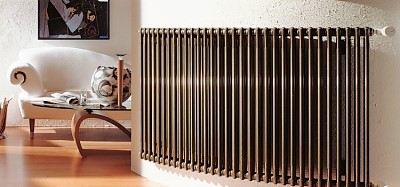
Preparing for winter involves a lot of different aspects, one of which is correct arrangement of the heating systemTo do this, you need to select the optimal type of radiators.
Installation of the heating system is carried out before the cold weather sets in. To facilitate the selection of the necessary devices, it is necessary understand all their varieties.
Content
Types of heating radiators
Exists several main varieties heating batteries, each of which has its own advantages and disadvantages.
Steel devices
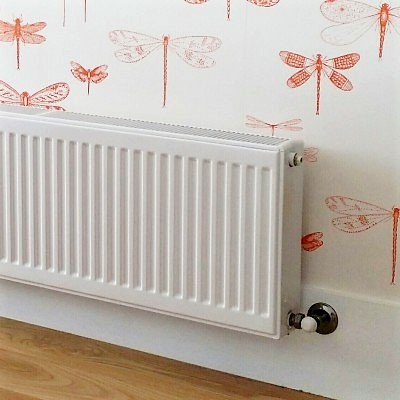
One of the most popular types of heating devices are steel radiators. Most often, they are manufactured not made of steel, but of an alloy of this material, characterized by improved properties and characteristics.
Design specifics steel radiators may vary depending on their model:
- There are indentations on two steel sheets, made by stamping, circulates through them coolant.
- Made on steel sheets letter P imprint, inside which heated air circulates air.
- On the reverse side there are P-shaped ribs, increasing heat transfer.
Thickness The number of sheets used may vary from 1.2 to 2 millimeters. The design of the products is restrained and strict. In order to make the aesthetics of the radiators more attractive, decorative screens can be installed on them.
Pros and cons
Main advantages steel radiators:
- not very significant thermal inertia;
- regulation of battery temperature by means of thermostats;
- good level of heat transfer;
- aesthetics;
- a significant range of products.
As for disadvantages, then them not very many:
- impossibility of installation in an open system;
- lack of compatibility with polypropylene pipes.
Characteristics
Experts highlight the following technical indicators of radiators:
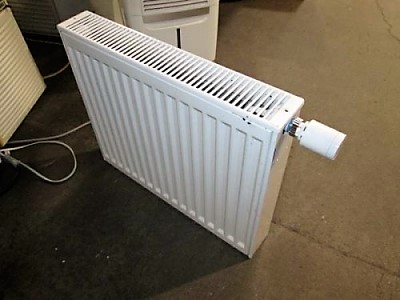
- heat transfer may vary depending on model from 1200 to 1800 Watts;
- working pressure in the range from 6 to 10 atmospheres (as for tubular batteries, they are capable of functioning at higher rates);
- coolant quality plays a significant role, since the inner surface begins to rust as soon as the water disappears from it;
- the coolant temperature can reach 110-120 degrees Celsius;
- height radiators depends on their type - it can be from 20 to 90 centimeters;
- length batteries are limited - no more than 3 meters;
- depth the device reaches 22.5 cm;
In accordance with their technical characteristics, steel radiators, when used correctly, can be quite durable.
Manufacturers
There are many different manufacturers of steel radiators:
- Kermi and Buderus (Germany);
- Israp Tesi (Italy);
- Lidea (Belarus);
- KZTO (Russia).
- KORADO Radik (Czech Republic);
- DeLonghi RADEL (Italy);
- Zehnder Charleston (Germany);
- PURMO (Finland).
The approximate cost of steel radiators depends on their type and model. The cheapest types can be purchased for 1000 rubles, while the price of the most expensive ones reaches 5000-6000 rubles.
Tubular steel batteries
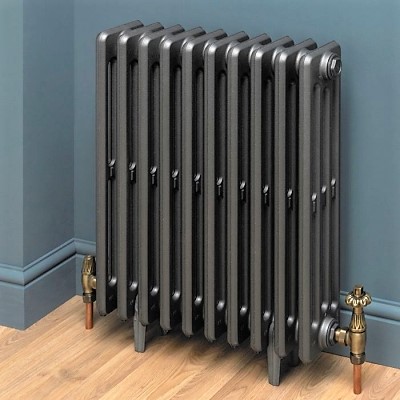
This type of radiators, such as tubular steel batteries, is a product premium class, which meets most modern requirements. The first such device was created in 1930, after which he constantly improved.
Steel tubular radiators can be made in various forms. All the tubes used in them are connected at the top and bottom by special collectors. This ensures efficient transportation of the coolant in the system.
The level of heat transfer directly depends on the size of the device, as well as the number of tubes in it.
The difference between tubular radiators is that at present for welding their elements a special laser is used. It makes a smooth and almost invisible seam.
Pros and cons
Main advantages steel tubular radiators:
- Resistance to pressure changes in the heating network. This is achieved through the tubular design.
- No significant accumulation of dust on the surface of the radiators.
- Attractive appearance achieved by the presence of streamlined smooth tubes.
- Availability of a large number of different forms.
- High-quality welded joints of batteries.
Despite all the advantages, steel tubular radiators also have flaws:
- Not very high heat output compared to other types of batteries.
- Susceptibility to corrosion in cases where the coolant is drained from the system during the summer.
- High cost.
Despite the fact that the price of tubular radiators is high, it pays for itself quickly thanks to long service life.
Characteristics
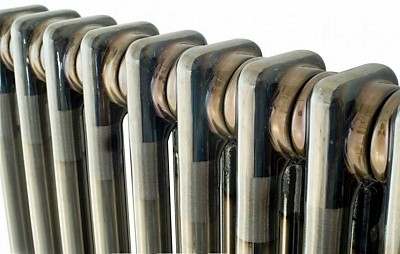
The particular popularity of tubular steel radiators is due to their characteristics:
- working pressure pipes reach 10 atmospheres;
- thickness the walls of steel pipes correspond 1.5 millimeters;
- height units can be within the range from 30 centimeters to 3 meters;
- maximum depth reaches 22.5 centimeters;
- number of tubes may vary in one row from 1 to 6 units.
Manufacturers
To the main domestic and foreign The following companies are considered manufacturers of tubular steel models:
- Purmo (Finland);
- Royal (Italy);
- Arbonia (Germany);
- Zehnder (Germany);
- Termica (Poland).
The cheapest tubular radiators can be purchased 1000 rubles each, and the most expensive designer batteries can reach 10,000-20,000 rubles per block.
What are the types of aluminum radiators
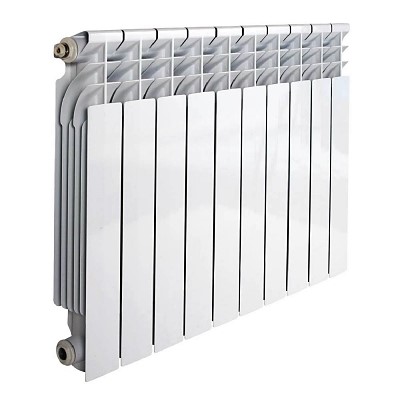
In the eighties last century in Italy The first heating devices made of aluminum appeared. In a short time, they gained significant popularity around the world. This was influenced by their fairly good technical characteristics.
Exists two main types aluminum radiators: cast and extruded.
The first of them They are a single-piece structure created by pouring molten metal into molds under high pressure.
As for second variety batteries, their profile is formed during the pressing process, after which it is cut into separate parts. Then the elements are connected in pairs to form a section. To ensure the required level of tightness, appropriate sealing materials are used.
Appearance of aluminum batteries very attractive. It suits most interior styles.
Pros and cons
Aluminum radiators are distinguished by a large number advantages:
- High level of heat transfer.
- Low system weight.
- Affordable cost compared to copper or cast iron appliances.
- Possibility of temperature regulation and installation of thermal valves.
- Beautiful appearance, suitable for most interior styles.
- Considerable strength.
Important! Because radiators use seals, they not suitable for systems where antifreeze is used or any other chemical substance as a heat carrier.
Other flaws:
- Weak resistance of batteries to corrosion. In order to increase it, it is necessary to use water with a low pH level.
- Airing of the system (this is facilitated by chemical reactions).
- The presence of weak spots in the thread connection areas.
Despite the presence of disadvantages, aluminum radiators have significant demand.
Characteristics
Main technical characteristics of aluminum radiators:
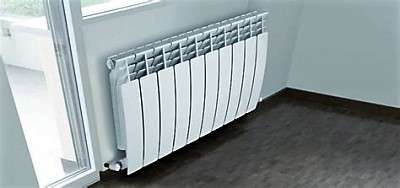
- distance between axles makes up from 350 to 500 millimeters;
- working pressure in most models it is within the range from 6 to 16 atmospheres (there are species where this indicator reaches 24 atmospheres);
- height batteries may vary from 38 to 59 centimeters;
- width devices limited 80 centimeters;
- power most often found within from 82 to 212 W;
- the coolant can warm up up to 110 degrees Celsius.
The above characteristics allow the use of aluminum radiators within 10-20 years without any problems with them.
Manufacturers
The main manufacturers of aluminum radiators include the following brands:
- Royal (Italy);
- Tessen (China);
- Global (Italy);
- Rifar (Russia);
- Ferroli (Italy, Poland).
The cheapest aluminum radiators can be purchased in Russia for 600 rubles. The average price range is within from 2000 to 5000 rubles. The most expensive devices cost up to 9000 rubles.
Cast iron types of heating devices
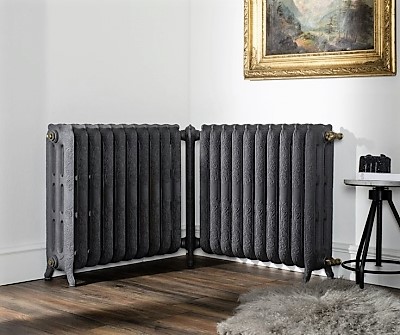
This type of radiators is classic. Despite the fact that many people currently consider these devices obsolete, they are still widespread. However, it is no longer possible to meet them in Western countries.
The main feature of cast iron radiators is their unattractive appearance. This concerns large sizes, the presence of joints, and the impossibility of using them in currently popular design solutions.
Cast iron radiators can be hidden behind special metal screens. But this, in turn, significantly worsens the speed of heating the premises.
Modern cast iron radiators are made with higher quality, but their appearance cannot be compared with other types of radiators.
Reference. It is also worth noting that there is Possibility of ordering designer batteries made of cast iron. They are real works of art. It is important to understand that for such work you will have to pay a lot of money.
Pros and cons
Main advantages cast iron radiators:
- High corrosion resistance. That is why the devices can be used for more than half a century.
- Optimal value for money.
- Possibility of using batteries in systems where not very clean coolant is used.
Main flaws cast iron radiators:
- Low heat output (no more than 20 percent).
- The need to use large pipes that are difficult to hide in the wall.
- Inability to heat up quickly.
Characteristics
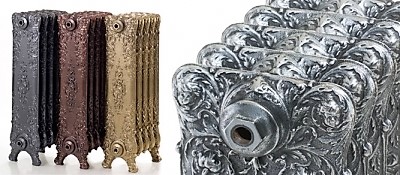
Characteristics of cast iron batteries:
- power 110 W;
- pressure from 9 to 12 atmospheres;
- the weight (of the section) often reaches 8-9 kilograms;
- height from 370 to 570 millimeters;
- width most often found within from 60 to 90 centimeters (there are also other rarer models).
Manufacturers
The main manufacturers of cast iron radiators include the following companies:
- Konner (Russia);
- Guratec (Germany);
- Roca (Spain);
- Demir Dokum (Türkiye).
Currently, the cheapest cast iron radiators can be purchased for 600 rubles. They are not distinguished by their designer appearance. Batteries that are more like works of art can cost up to 2000-3000 rubles.
Bimetallic radiators
Various experiments in creating the highest quality radiators led to the production of batteries made from two types of metalsThis ultimately made it possible to use the advantages of both materials.
As a result, such devices have gained significant popularity, since their characteristics are significantly are different for the better from alternative heating sources.
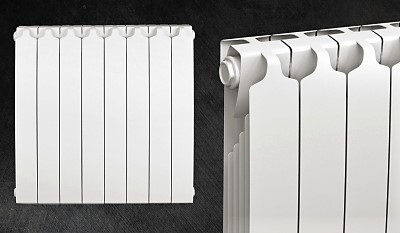
The main difference of the bimetallic type special jumpers available. Manufacturers often use as the main materials steel and aluminum.
The part of the battery that is less susceptible to corrosion comes into contact with the coolant, while those elements that better transfer heat to the premises come into contact with the air.
The inner part of bimetallic radiators usually contains tubes that are connected to flat plates on the outside, which act as a kind of protective screen. Such devices are modern devices in their appearance, suitable for most types of interiors.
Pros and cons
The popularity of bimetallic radiators is due to a number of their positive qualities. The main advantages:
- Long service life - from 20 to 50 years old.
- High strength and resistance to fairly strong hydraulic shocks.
- Significant heat transfer rates, which can reach up to 200 W.
- Resistance to corrosion. This applies even to those cases when a low-quality heat carrier is used.
- Beautiful appearance, allowing them to be used even in rooms with a modern design.
As for disadvantages, then they are in bimetallic radiators not very much:
- Relatively high cost, which exceeds the price of other batteries several times.
- Some models may be susceptible to rust (but this is rather an exception to the general rule).
Thus, a large number of positive qualities of using bimetallic radiators made these devices some of the most popular last time.
Characteristics
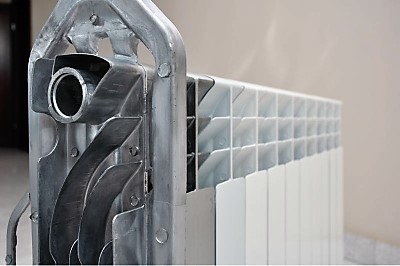
Main technical characteristics of bimetallic radiators:
- heat transfer level is within the limits from 170 to 190 W;
- strength reaches 20-25 atmospheres (some devices can withstand readings several times higher);
- height batteries are 415-575 millimeters;
- width - from 80 to 100 millimeters;
- weight does not exceed 2 kilograms;
- the coolant temperature reaches 135 degrees Celsius.
The above characteristics of bimetallic radiators are the main ones. In addition to them, there are also a lot of other indicators, depending on the specific model.
Manufacturers
Main brands of bimetallic radiators:
- Global (Italy);
- Rifar (Russia);
- Radiators (Italy);
- Oasis (Germany).
The cost of bimetallic batteries directly depends on the manufacturer. Some radiators can be purchased for 1000-2000 rubles, while others require more significant funding - from 6000 to 12000 rubles.
An unusual option: floor convectors
In order to avoid installing conventional batteries under windows, many people prefer to install them in their apartments and houses. heated floorsFor this purpose, floor convectors are used, releasing warm air through openings in the upper floor covering.
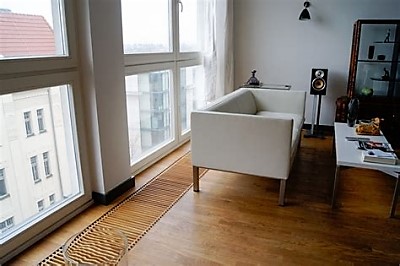
Floor convectors are tubes made of copper and aluminumWater, which is a coolant, flows through them.
The heat exchanger can have either both round and square section. In parallel to this element are attached corresponding plates. They can be made using aluminum, zinc or steel. This increases the heating area.
Convectors, floor mounted, can be angular or radial shape. But at the same time, the buyer can order a wide variety of types of these devices depending on the size of his room.
Important! On the floor they are closed with special gratings, which is why there is no free access to the structure.
Pros and cons
Main Pros floor convectors:
- Possibility of freeing up space under windows.
- Rapid heating of air.
- Saving energy resources, since a large volume of coolant is not required.
- Possibility of installation in rooms with panoramic windows.
- Light weight construction.
- Safety for humans, as the temperature of the grill does not rise above 40 degrees Celsius.
Floor convectors have the following flaws:
- Difficulty of installation.
- The need for constant monitoring of cleanliness.
- Cannot be used in rooms with very high ceilings.
Characteristics
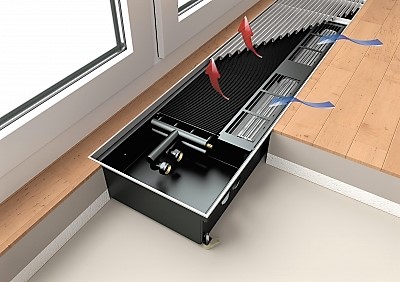
Technical characteristics of floor convectors:
- length may vary from 800 to 3300 millimeters;
- width is within the limits from 220 to 380 millimeters;
- height makes up from 50 to 250 millimeters;
- average working pressure does not exceed 10-15 atmospheres;
- heat transfer the device is significant - from 200 to 14000 W;
- the coolant temperature is within the limits from 105 to 130 degrees Celsius.
The above mentioned characteristics of the device allowed him to easily heat large spaces.
Manufacturers
The main companies that produce floor convectors are such well-known brands as:
- Verano (Poland);
- Polvax (Ukraine);
- Mohlenhoff (Germany);
- Jaga (Belgium).
Most floor convectors are quite expensive. Their lowest price starts at 20 thousand rubles. The most expensive devices are - more than 50 thousand rubles.
Skirting convectors heating
Skirting convectors have become a new technology for heating rooms. They are almost no different from in-floor devices, except for the method of its installation.
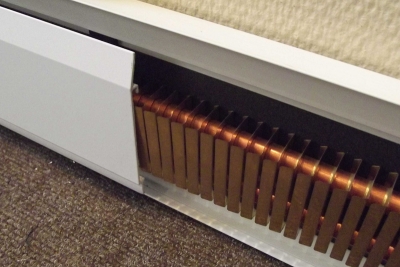
The devices can be either thermomechanical, and thermoelectric.
The baseboard convector radiator block consists of aluminum pipes, which have small overall dimensions. They are connected to each other by means of plastic pipes.
Special fasteners are attached to the outside of the device. vertical slats made of aluminum or brassThis allows for more efficient heat transfer into the room.
Installation of convectors is carried out along the perimeter of the wall at its lowest part — where the baseboards are located.
Pros and cons
Main advantages use of baseboard convectors:
- No convection effect.
- Uniform heat distribution.
- No heat accumulation under the ceiling.
- Quick installation.
- Saving resources due to the lack of need to heat the coolant very much.
- Availability of special thermostats.
- Possibility of quick repair.
Essential flaws baseboard radiators:
- High cost of devices and their installation.
- Limitation maximum length one circuit 15 meters.
- Impossibility of installing decorative trims.
- The impossibility of distributing a large amount of furniture around the perimeter of the room.
Currently, skirting convectors are not very common.
Characteristics
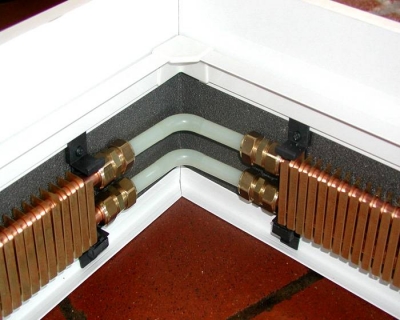
Main technical and operational characteristics of skirting convectors:
- heating of the coolant up to 85 degrees Celsius;
- height - 160 millimeters;
- length - 1500 millimeters;
- depth limited 40 millimeters;
- power - from 180 to 270 W;
- the mass does not exceed 4 kilograms.
The characteristics directly depend on the model and type of device used.
Manufacturers
Popular manufacturers of baseboard convectors are the following companies:
- Thermia (Ukraine);
- Carrera (Italy);
- TherModule (Italy);
The cheapest convector skirting board devices can be purchased for 1500-2000 rubles. Expensive devices can cost from 15 to 20 thousand rubles.
Photo of installed batteries
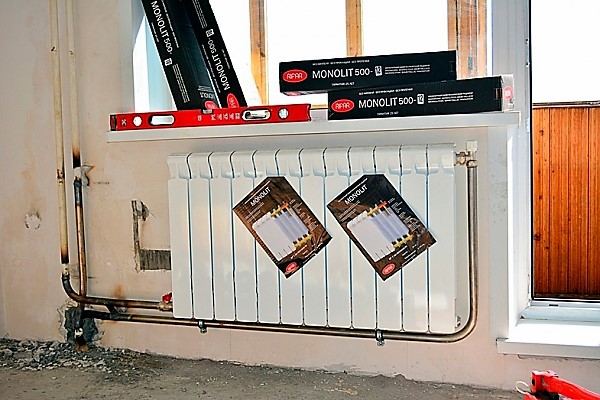
Photo 1. Bimetallic radiators Monolith from the Russian company Rifar, installed on the wall under the window.
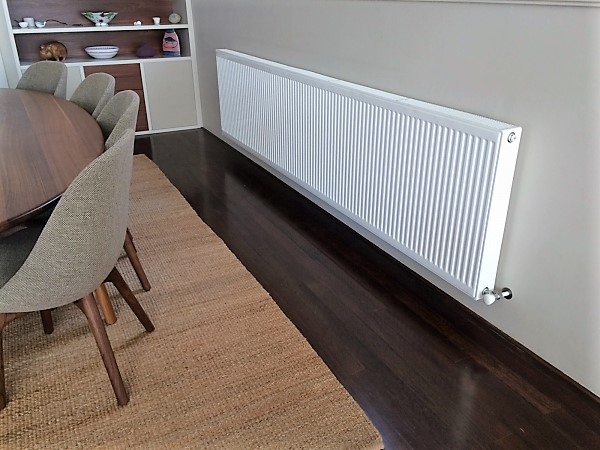
Photo 2. Steel heating radiators DeLonghi Radel with bottom connection to the heating system.
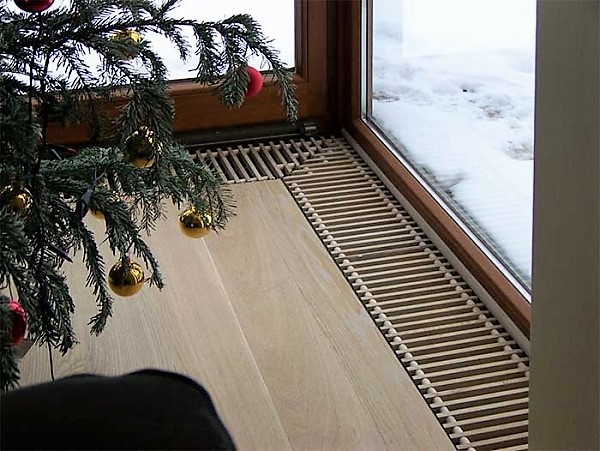
Photo 3. Convectors installed in the floor along the perimeter of panoramic windows help keep the house warm.
Useful video
The video tells about the rules for choosing heating radiators: what is working pressure, how to calculate heat output and what price is really profitable.
Conclusion. How to choose a heating device?
Currently there is a huge amount various manufacturers of radiators and convectors. This applies to both Russian companies, and foreign brands.
They all differ in the types of their products, their technical characteristics, and have its advantages and disadvantages. That is why, before purchasing any battery for arranging a heating system for premises, you need to analyze all the options available on the market.





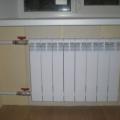
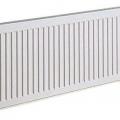
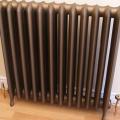
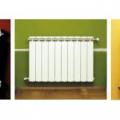
Comments
Well, tubular steel radiators heat better and hotter. Although I chose aluminum anyway. Because steel ones can leak in a couple of years and will have to be replaced.